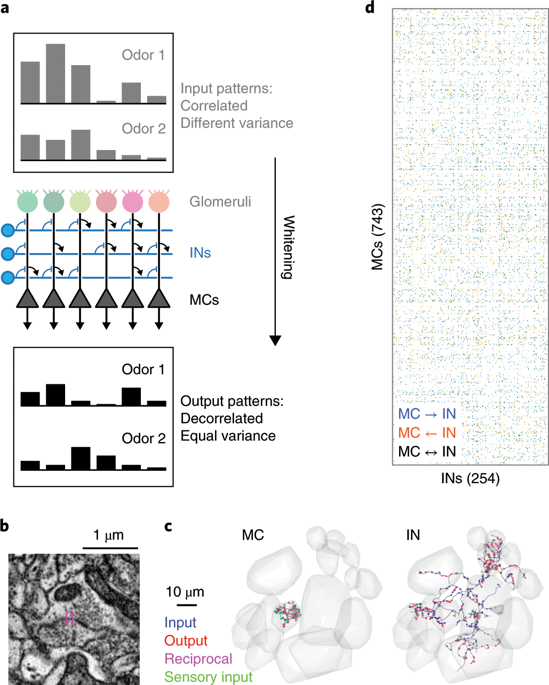当前位置:
X-MOL 学术
›
Nat. Neurosci.
›
论文详情
Our official English website, www.x-mol.net, welcomes your
feedback! (Note: you will need to create a separate account there.)
Whitening of odor representations by the wiring diagram of the olfactory bulb.
Nature Neuroscience ( IF 21.2 ) Pub Date : 2020-01-20 , DOI: 10.1038/s41593-019-0576-z Adrian A Wanner 1, 2, 3 , Rainer W Friedrich 1, 2
Nature Neuroscience ( IF 21.2 ) Pub Date : 2020-01-20 , DOI: 10.1038/s41593-019-0576-z Adrian A Wanner 1, 2, 3 , Rainer W Friedrich 1, 2
Affiliation

|
Neuronal computations underlying higher brain functions depend on synaptic interactions among specific neurons. A mechanistic understanding of such computations requires wiring diagrams of neuronal networks. In this study, we examined how the olfactory bulb (OB) performs 'whitening', a fundamental computation that decorrelates activity patterns and supports their classification by memory networks. We measured odor-evoked activity in the OB of a zebrafish larva and subsequently reconstructed the complete wiring diagram by volumetric electron microscopy. The resulting functional connectome revealed an over-representation of multisynaptic connectivity motifs that mediate reciprocal inhibition between neurons with similar tuning. This connectivity suppressed redundant responses and was necessary and sufficient to reproduce whitening in simulations. Whitening of odor representations is therefore mediated by higher-order structure in the wiring diagram that is adapted to natural input patterns.
中文翻译:

嗅球接线图使气味变白。
大脑功能较高的神经元计算取决于特定神经元之间的突触相互作用。对此类计算的机械理解需要神经网络的接线图。在这项研究中,我们研究了嗅球(OB)如何执行“增白”,这是一种对活动模式进行去相关并通过内存网络支持其分类的基本计算。我们在斑马鱼幼虫的OB中测量了气味诱发的活性,随后通过体积电子显微镜重建了完整的接线图。所产生的功能性连接体揭示了多突触连接性基元的过度代表,这些基元介导具有相似调节的神经元之间的相互抑制。这种连通性抑制了冗余响应,并且对于在仿真中重现白化是必要且充分的。因此,气味表示的增白是由适合于自然输入模式的接线图中的高级结构介导的。
更新日期:2020-01-20
中文翻译:

嗅球接线图使气味变白。
大脑功能较高的神经元计算取决于特定神经元之间的突触相互作用。对此类计算的机械理解需要神经网络的接线图。在这项研究中,我们研究了嗅球(OB)如何执行“增白”,这是一种对活动模式进行去相关并通过内存网络支持其分类的基本计算。我们在斑马鱼幼虫的OB中测量了气味诱发的活性,随后通过体积电子显微镜重建了完整的接线图。所产生的功能性连接体揭示了多突触连接性基元的过度代表,这些基元介导具有相似调节的神经元之间的相互抑制。这种连通性抑制了冗余响应,并且对于在仿真中重现白化是必要且充分的。因此,气味表示的增白是由适合于自然输入模式的接线图中的高级结构介导的。











































 京公网安备 11010802027423号
京公网安备 11010802027423号